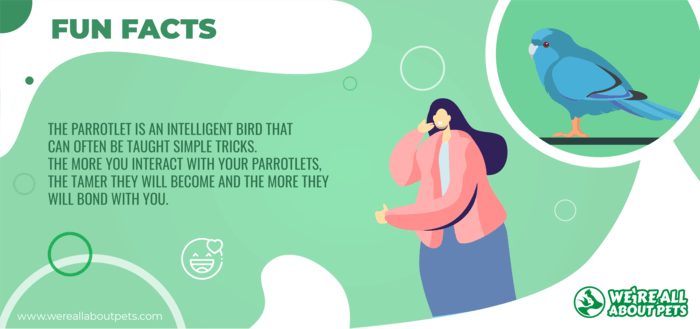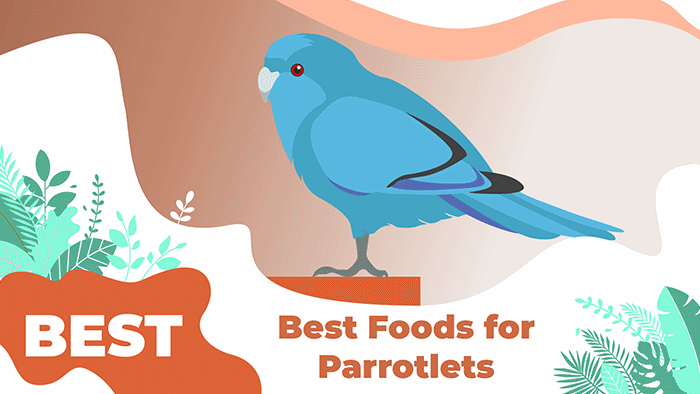How To Care For A Parrotlet?
This page contains affiliate links. We may earn money or products from the companies mentioned in this post through our independently chosen links, which earn us a commission. Learn More
General Stats:
- Pet Type: Bird
- Size: Up to 5 inches
- Diet: Omnivore
- Lifespan: Up to 20 years
They may be small, but parrotlets have big personalities and can be quite a handful to manage at times. These little birds need plenty of human interaction and exercise, as well as a healthy diet.
Don’t let the small size of the parrotlet fool you – these birds can be a lot of work, especially compared to other small birds like the lovebird or budgie. Parrotlets may take time and dedication, but they are well worth the effort for pet owners.
Here’s what you need to know about caring for a parrotlet.
Habitat Setup For Parrotlets

As a social bird, your pet parrotlet should be kept in groups with others of its species. There are several species of parrotlet, though the most common in the pet trade are the Pactific parrotlet and the green-rumped parrotlet. You may be able to mix different species of parrotlet, though larger cages are recommended for larger groups of pet birds. Avoid keeping parrotlets with other parrots including the conure, cockatiel, and macaws.
Though they may be small birds, parrotlets are active birds and require plenty of space to play. Remember, however, that parrotlets are small, so look for a bird cage with no more than ¼-inch bar spacing. Horizontal bars on at least part of the cage are recommended for climbing.
Here are some of the items you’ll need for your parrotlet cage:
- Cage – The best cage for a parrotlet is at least 18×18 inches, though you should look for a cage size at least 40x20x20 inches for a pair of parrotlets and larger cages for larger groups.
- Perches – Provide at least two perches of different thickness and material, placing them at different heights around the cage.
- Toys – Your parrotlet needs plenty of toys to keep him busy. Swings, bells, squeakers, balls, ladders, and ropes all make great choices.
- Food/Water Dishes – Food dishes and water dishes should not be placed directly below a perch and should be cleaned daily. Keep clean water available at all times – you might even try a water bottle, though a water dish allows for more natural behavior.
- Nest Box – If you plan to keep a breeding pair of parrotlets, you’ll need a nesting box in your cage. It should be about 6x10x7 inches and filled with unscented nesting material.
When choosing the location for parrotlet’s cage, make sure you choose an area out of direct sunlight and away from air vents and drafts. Parrots are very sensitive to changes in temperature and should be kept away from smoke and cooking smells as well.
Parrotlet Diet

In the wild, parrotlets feed on a variety of seeds and berries as well as some grains and other vegetation. As a parrotlet owner, you can choose whether to fee your parrotlet seed mix or a commercial pelleted food – there are pros and cons to both options.
Here are some quick facts about the ideal parrotlet diet:
- If you choose a seed mix for your parrotlet’s diet, it should only make up about 60% of the diet as a whole and you may want to still offer some pellets – make sure the seed mix has at least 5 different types of seed with different nutritional profiles.
- Commercial pellets provide complete and balanced nutrition for parrotlets but not all pet birds are used to eating them – you will also still need to supplement the diet with fresh foods.
- Offer your parrotlet fresh fruits and fresh vegetables up to 20% or 25% of its daily diet – make sure they are in small pieces and offer a variety throughout the week.
- Include a cuttlebone in your parrotlet’s cage to provide enrichment and to help meet his needs for calcium – your pet bird doesn’t need any grit.
- Occasional treats can be offered in the form of cooked egg, shelled nuts, and sunflower seeds.
In addition to food, be sure to provide your pet with unlimited access to fresh water as well. In the wild, parrotlets get the majority of their hydration from food, but you’ll need to provide a water bowl.
Parrotlet Veterinary Care

When you first bring your pet bird home, you may want to give him a few days to adjust to his new environment. After that, you should begin handling the bird to get a feel for his personality and to check for signs of illness. Take your pet parrotlet to the vet within a week or two of getting him so you can establish a baseline for his health and wellness.
A key aspect in proper parrotlet care is staying on top of developing health problems. With your vet’s help, and with some basic knowledge of common health problems, you can spot issues in the early stages and seek treatment for your bird.
Here are some of the most common health problems in parrotlets:
- Candida
- Respiratory problems
- Psittacosis (parrot fever)
- Nasal discharge
- Psittacine beak and feather disease
- Tracheitis
- Aspergillosis
- Egg binding
Many pet stores offer a guarantee on the health of their pets, but it may only last 14 days or so. If your bird gets sick after that, you’ll have to find an avian vet and pay for treatment yourself. It’s a good idea to have a vet lined up before you bring your pet home so you know where you’ll take him and so you can get an estimate on costs.
Parrotlet Fun Facts

- The parrotlet is an intelligent bird that can often be taught simple tricks. The more you interact with your parrotlets, the tamer they will become and the more they will bond with you.
- Parrotlets don’t tend to be very noisy which makes them a great choice for apartments. They aren’t strong talkers either, though they will repeat words and simple phrases.
- Wild parrotlets will not lay eggs unless they have both a suitable mate and a suitable nesting site. In captivity, however, female parrotlets sometimes lay eggs in the absence of a mate. The average clutch size ranges from 4 to 7 eggs but can be as large as 10 eggs.
- Though they may be small, parrotlets have a surprisingly long lifespan that averages around 20 years but has been known to exceed 30 years in captivity.
- In the wild, parrotlets are extremely active birds, often spending hours a day foraging for food and staying out of the way of predators – these birds need a lot of exercise in captivity to remain healthy.
- Parrotlets are Amazon parrots, found wild throughout Mexico as well as Central and South America. These birds live in flocks ranging from a few pairs up to 100 birds.
If you’re looking for a low maintenance pet bird, the parrotlet may not be the right choice for you. However, if you’re willing to commit a significant amount of time, they might be one to consider.
Be sure to do your research before bringing home a new pet to ensure you can cover the costs to care for your pet and to make sure you understand its care requirements.
Frequently Asked Questions
How long do parrotlets live?
The average lifespan for a pet parrotlet is up to 20 years.
How much do parrotlets cost?
The cost to purchase a parrotlet varies between species and among different color mutations. The Pacific and Mexican parrotlets are the most affordable species while the spectacled parrotlet is one of the most expensive. Plan to spend $100 to $500 on your bird and an additional $150 to $500 on the cage setup. Factor in additional costs for food and veterinary care.
How big do parrotlets get?
Slightly smaller in size than a parakeet or budgie, parrotlets grow to about 5 inches in length. Not only are they a small bird, but they are the smallest type of parrot. They are often called pocket parrots.
What do parrotlets eat?
Parrotlets feed on a diet of seeds, berries, fruits, and veggies in the wild. A pet parrotlet’s diet should be a balanced blend of nutrients, primarily from seed mix or commercial pellets. Offer fresh foods like berries, fruits, and vegetables as well as occasional treats.
Are parrotlets good pets?
Not only are parrotlets fairly small birds, but they also tend to be fairly quiet. These birds will chirp a little and repeat words or phrases, but they are much less noisy than larger parrots like macaws. The challenge is that they need to be kept in pairs or groups and require a lot of exercise and interaction.
Are parrotlets messy?
Though all birds have the potential to be a little messy, parrotlets are known for this. They drop food all over their cages and keeping a group of them together increases the risk for fighting which means feathers all over the place. Using a cage liner on the bottom of the cage can help make cage cleanup easier on you.
Where do parrotlets come from?
There are several species of parrotlet, though only a few are popular as pet birds. The Pacific parrotlet (Forpus coelestis) is the most popular and originated in Mexico and South America. Other species include the green-rumped parrotlet (Forpus passerinus), Mexican parrotlet (Forpus cyanopygius), and spectacled parrotlet (Forpus conspicillatus).
Do parrotlets bite?
Like many parrots, parrotlets can bond closely with their owners and they do not tend to bite. Any bird will, however, defend itself if it feels threatened. In some cases, if your parrotlet starts biting and it is an unusual behavior for him, it could be trying to communicate something with you – take a closer look to see if you can find the reason for the change in behavior.
Do parrotlets sleep?
Parrotlets follow a similar sleep cycle to humans, sleeping during the night and being active during the day. Your pet needs about 12 hours of sleep at night, so consider covering the cage to keep it dark enough for sleep.
How long are parrotlets pregnant for?
Parrotlets generally need to be about a year old before breeding and should be kept in pairs for the purpose. The average clutch size is 4 to 7 eggs and, in many cases, the female won’t lay eggs in the absence of a mate. Most female parrotlets wait until the second or third egg to begin incubating and the eggs usually hatch after about 19 days.










chris
I have female and male parrolets and the female is laying like 2 eggs and the male is ALWAYS BREAKING them.